|
Allied Military Government issues
France was liberated starting with D-Day, June 6, 1944. AMG
stamps were issued later in the year and were in use until superseded by
stamps of the Free French government in 1945.
The stamps are denominated in the French currency, centimes and francs.
The stamps were printed by the Bureau of Engraving and Printing in
Washington, DC. The plate number fonts and positioning are similar
to those used on the U.S. Documentary stamps of the same period. They are frequently collected as pairs or blocks, as care was not taken
during the design process to ensure that the plate number appeared on the selvage of
a single stamp.
First series, single colors, 1944
.jpg) Scott
2N1 / France Scott 475, 5 centimes, plate number 45440 Scott
2N1 / France Scott 475, 5 centimes, plate number 45440
.jpg) Scott
2N2 / France Scott 476, 10c, plate number 45474 Scott
2N2 / France Scott 476, 10c, plate number 45474
.jpg) Scott
2N3 / France Scott 476A, 25c, plate number 45442 Scott
2N3 / France Scott 476A, 25c, plate number 45442
.jpg) Scott
2N4 / France Scott 476B, 50c, plate number 45437 Scott
2N4 / France Scott 476B, 50c, plate number 45437
.jpg) Scott
2N5 / France Scott 476C, 1 franc, plate number 45443 Scott
2N5 / France Scott 476C, 1 franc, plate number 45443
.jpg) Scott
2N6 / France Scott 476D, 1 fr 50, plate number 45444 Scott
2N6 / France Scott 476D, 1 fr 50, plate number 45444
The use of plural "francs" was grammatically incorrect.
.jpg) Scott
2N7 / France Scott 476E, 2 fr 50, plate number 45445 Scott
2N7 / France Scott 476E, 2 fr 50, plate number 45445
.jpg) Scott
2N8 / France Scott 476F, 4 fr, plate number 45568 Scott
2N8 / France Scott 476F, 4 fr, plate number 45568
.jpg) Scott
2N9 / France Scott 476G, 5 fr, plate number 45446 Scott
2N9 / France Scott 476G, 5 fr, plate number 45446
.jpg) Scott
2N10 / France Scott 476H, 10 fr, plate number 45475 Scott
2N10 / France Scott 476H, 10 fr, plate number 45475
Second series, bi-colored, denominations in
black, 1945
The second series required two plates. Plate 45891 was used to
print the different colors for the Arc de Triomphe, with separate plates
used to print each denomination in black. BEP would later do
something similar with the final U.S. postage due series, using common
plates for the background with a separate process similar to overprints or precancellations for the denominations.
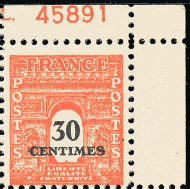
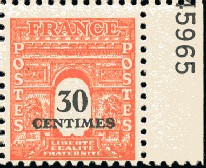
Scott
2N11 / France Scott 523A, 30c, plate number 45891 and 45965
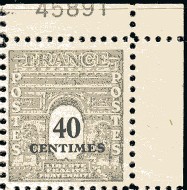
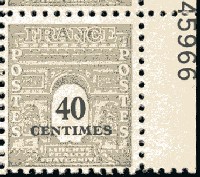
Scott
2N12 / France Scott 523B, 40c, plate number 45891 and 45966
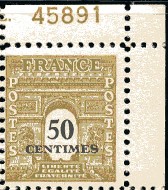
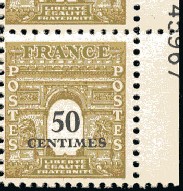
Scott
2N13 / France Scott 523C, 50c, plate number 45891 and 45967
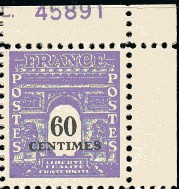
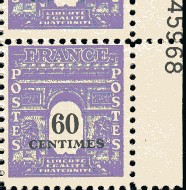
Scott
2N14 / France Scott 523D, 60c, plate number 45891 and 45968
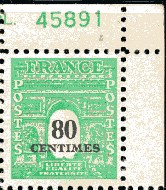
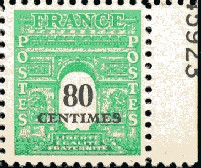
Scott
2N15 / France Scott 523E, 80c, plate number 45891 and 45923
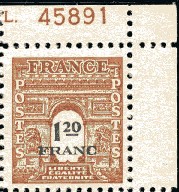
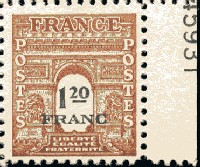
Scott
2N16 / France Scott 523F, 1.20 fr, plate number 45891 and
45931
For the second printing, denominations of only 1 franc correctly use the singular "franc."
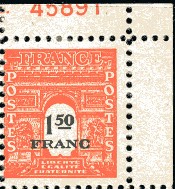
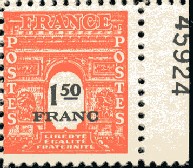
Scott
2N17 / France Scott 523G, 1.50 fr, plate number 45891 and
45924
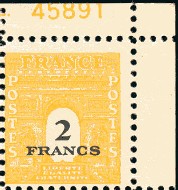
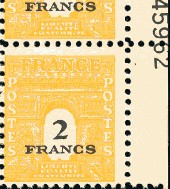
Scott
2N18 / France Scott 523H, 2 fr, plate number 45891 and 45962
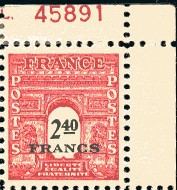
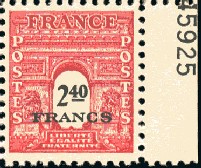
Scott
2N19 / France Scott 523I, 2.40 fr, plate number 45891 and
45925
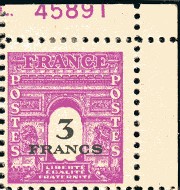
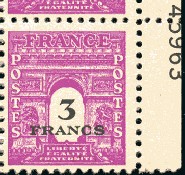
Scott
2N20 / France Scott 523J, 3 fr, plate number 45891 and 45963
All AMG-France PNS examples have been photographically cropped from
plate blocks of six. Images courtesy of the late Wallace Cleland.
R.F. Overprints
The 6¢ Transport airmail was overprinted with various markings of "R.F." (for Republique française) for use by French naval personnel on airmail correspondence to the U.S. and Canada in 1944 and 1945.
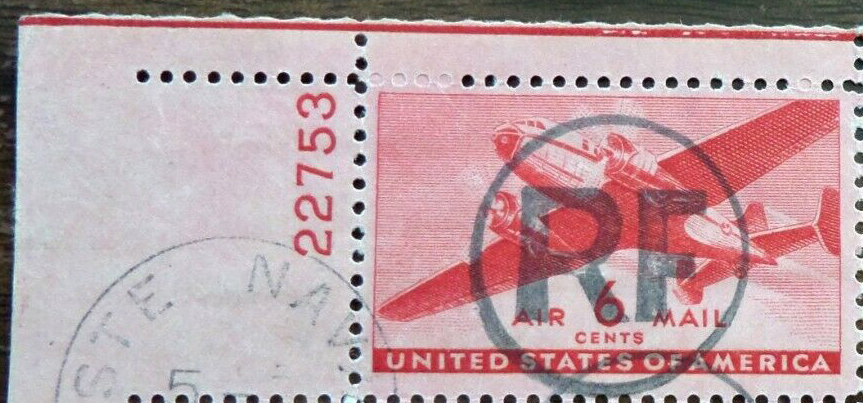
Scott C25, plate number 22753, with counterfeit overprint and fake cancellation, photographically cropped from a used plate block purporting to be a new variety of Scott CM1-CM12
Clues:
-- Genuine R.F. overprints are always collected on cover, to verify authenticity of the overprint and usage.
--
No genuine plate number items of this overprint are known. In fact, no pairs or any other multiples are known.
-- The large sans-serif RF in circle is not one of the known authentic R.F. overprint types. So we are asked to believe that this is not only the discovery copy of a used multiple, of a used plate block, and of a plate block in any condition, but also of a new overprint type never previously reported.
-- The gray ink of both the R.F. overprint and POSTE NAVALE cancellation is more of the home ink-pad type
than of the professional printer-quality black ink used for genuine overprints and cancellations.
-- The font and spacing of POSTE NAVALE, and the font of the numbers in the purported cancellation date, do not match that of any other example.
-- Mis-use of even the
genuine cancellation devices and overprints to create fake examples after 1945 is commonly known.
-- The cancellation barely touches the two leftmost stamps in the plate block, and there is no cancellation whatsoever on the other two stamps. We are asked to believe that the stamps were not properly canceled by the French Naval Post sailor, and this was not noticed by the censor, any other French Naval Post worker, any American Military Post worker when the item was accepted from the French Naval Post, or any of the dozens of U.S. or Canadian postal workers who handled the item on its way to its delivery address. If this item was actually mailed, surely someone would have given the other two stamps the 1944 equivalent of the felt-tip pen treatment.
-- The (fake) cancellation is firmly and evenly struck - in fact, it's "too clean" -- yet the month of the cancellation is illegible. This is not known on any other example.
-- There are fewer than 60 examples of known, valid overprint types in The Philatelic Foundation data base. The vast majority received certificates indicating the overprint, cancellation or both are counterfeit, fraudulent or similar synonyms for fake. And this is for examples on cover. Examples not on cover are highly suspicious.
-- The bottom portion of the fake cancellation is atop a handwritten pencil counting number in the sheet margin. This is an indication that the original pane of 50 was #395 out of a pad of 1000 upper left panes that would typically have been delivered to a large city post office.
There is no reliable census of how many R.F. overprints were made, but estimates are in the hundreds over a period of about 18 months, not the 200,000+ in one go that is implied by this counting number.
-- Genuine examples of single stamps on cover catalogue at $300 and up.
This plate block, which would be unique if genuine, was offered on eBay for a mere $29.99. Plus $4 shipping.
--
Plate 22753 was certified and went to press in 1941. It seems more likely that the U.S. post office would have furnished stamps from plates recently printed in 1944 for this purpose.
Comments? Suggestions? Email the
Webmaster: 
This page last updated April 15, 2021. 
|
.jpg) Scott
2N1 / France Scott 475, 5 centimes, plate number 45440
Scott
2N1 / France Scott 475, 5 centimes, plate number 45440.jpg) Scott
2N2 / France Scott 476, 10c, plate number 45474
Scott
2N2 / France Scott 476, 10c, plate number 45474.jpg) Scott
2N3 / France Scott 476A, 25c, plate number 45442
Scott
2N3 / France Scott 476A, 25c, plate number 45442.jpg) Scott
2N4 / France Scott 476B, 50c, plate number 45437
Scott
2N4 / France Scott 476B, 50c, plate number 45437.jpg) Scott
2N5 / France Scott 476C, 1 franc, plate number 45443
Scott
2N5 / France Scott 476C, 1 franc, plate number 45443.jpg) Scott
2N6 / France Scott 476D, 1 fr 50, plate number 45444
Scott
2N6 / France Scott 476D, 1 fr 50, plate number 45444.jpg) Scott
2N7 / France Scott 476E, 2 fr 50, plate number 45445
Scott
2N7 / France Scott 476E, 2 fr 50, plate number 45445.jpg) Scott
2N8 / France Scott 476F, 4 fr, plate number 45568
Scott
2N8 / France Scott 476F, 4 fr, plate number 45568.jpg) Scott
2N9 / France Scott 476G, 5 fr, plate number 45446
Scott
2N9 / France Scott 476G, 5 fr, plate number 45446.jpg) Scott
2N10 / France Scott 476H, 10 fr, plate number 45475
Scott
2N10 / France Scott 476H, 10 fr, plate number 45475




















